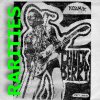 [Edited version from original post dated 25-12-2017]
[Edited version from original post dated 25-12-2017]
Some time ago this blog had a large article on
cover variants of the album Chuck Berry On Stage (Chess LP-1480). I had promised a follow-up on Vinyl variants of this album and because a recent discussion with a reader showed that most information about this album floating around on the Net is incorrect, here it comes.
Letâs start with some background information: From early 1962 to late 1963 Chuck Berry was behind bars. Berryâs previous records sold poorly due to his trials. During his prison stay he was not allowed to record new material in the studios. His record company CHESS only had a small stock of unreleased recordings.
Thus the record company was caught cold when new bands on both sides of the Atlantic became successful by covering Berry material. The Beach Boys'
Surfinâ USA was released in March 1963, the Stonesâ version of
Come On in June.
Memphis was a hit by Lonnie Mack and the Beatles had several Berry songs in their repertoire.
There was an urgent need for a new Berry album, but there was nothing to put on it. The Chess brothers dug through their archives and looked for unreleased material recorded during the previous years. They found four tracks recorded August 1961 which they considered worth for release:
Trick or Treat,
The Man And The Donkey,
All Aboard, and a re-recording of
Brown Eyed Handsome Man. Two recordings were left from an April 1960 session:
Crying Steel and
I Still Got The Blues. And there was
I Just Want To Make Love To You recorded in July 1959. These seven songs were selected. Today we know that there were other unreleased recordings such as
House Of Blue Lights, Time Was, 21 Blues, Oh Yeah, Do You Love Me, Iâm Just A Lucky So And So, or
Adulteen. None was regarded as appropriate by the studio bosses, though.
Seven songs are not enough for an album and none of it was good enough for a single. So what to do?
The Chess brothers were known for their creativity so they came up with a creative solution. Why not fill the album with older material released some years ago? OK, they already did a Greatest Hits album called
Chuck Berry Twist in 1962. But why not change the hits a little bit so nobody notices?
Letâs use different song titles and letâs add some audience noise to make the album sound like it was recorded live!
I have done studio albums that ultimately sounded like "live" albums. We did a "live" Chuck Berry album, and the world didn't know that Chuck Berry was in jail at that time. We actually were releasing previously unreleased tapes that were in the can. Then we thought we'd come up with a remote which would let us release old tunes that were supposedly "live". So I found the original takes with the count-offs and the dumb endings and everything else, and I cut it all together and created a performance. Then we sweetened it, but the audience sounded phony. However, the Beatles were doing some concerts during the same time period, and the kids were screaming all the way through their concerts. So I used those audience screams, and had a continuous roar during the whole album ... at the end it got real loud. I even had the audience singing with Chuck Berry — if you ride the control along with the words it sounds like the audience's reaction is singing the words. [Ron Malo, Modern Recording & Music, Vol. 6, No. 12, Sept. 1981, p. 58]
To disguise this fake even more, the Chess brothers asked Rodney Jones, who was a DJ with the Chess-owned WVON radio station, to add a little introduction. So Jones proudly announces âWelcome to the Tivoli Theatre here in Chicago ...â
The editing and engineering work to add the fake applause and Jonesâ shouts must have been done by Ron Malo sometime in May 1963. The two album sides were mastered from the resulting tape by the end of May or beginning of June and received the Chess master numbers 12477 (side 1, 16â25â) and 12478 (side 2, 14â14â).
Not telling anyone about the fake nature of this album, the liner notes proudly lied:
On this LP we present the world famous Chuck Berry in a jumping, in-person theatre appearance with thousands of fans enthusiastically responding to Chuckâs great performance. Any performer will tell you that he prefers to record in front of a live audience. There is nothing like the cheers and applause of an audience to spur a performer on to the heights of his ability and Chuck really gives his all in front of this packed theatre.
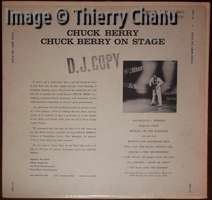
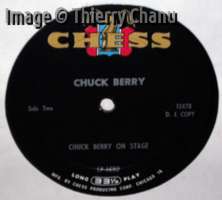
To completely confuse the buyers, the album came without a track listing. The back cover has a non-ordered and incomplete list of songs contained (and the image of an eight-year old LP). The labels simply say
Side One and
Side Two without any song titles at all. This obfuscation has resulted in incorrect track listings on the Net. Despite everything you read on discogs or wikipedia, the contents of the original US album
Chuck Berry On Stage, released in August 1963 as CHESS LP-1480, is as follows:
Side 1:
- Introduction by Rodney Jones
- Go Go Go â originally released in 1961 on CHESS 1799 b/w Come On
- Memphis, Tennessee (title shortened to Memphis) â originally released in 1959 on CHESS 1729 b/w Back in the USA
- Maybellene (now written as Maybelline) â originally released in 1955 on CHESS 1604 b/w Wee Wee Hours
- Crying Steel (here named Surfing Steel) â finally released less overdub in 1988
- Let It Rock (renamed to Rocking On The Railroad) â originally released in 1960 on CHESS 1747 b/w Too Pooped To Pop
- Brown Eyed Handsome Man â finally released less overdub in 1979
- I Still Got The Blues (as Still Got The Blues) â finally released less overdub in 1993
Side 2:
- Sweet Little Sixteen (renamed to Surfinâ USA) â originally released in 1958 on CHESS 1683 b/w Reelinâ And Rockinâ
- Jaguar And The Thunderbird â originally released in 1960 on CHESS 1767 b/w Our Little Rendezvous
- I Just Want To Make Love To You â finally released less overdub in 1993
- All Aboard â finally released less overdub in 2003
- Trick Or Treat â finally released less overdub in 2009
- The Man And The Donkey â finally released less overdub in 1974
- How High The Moon â finally released less overdub in 1979
How High The Moon is a 1940s jazz standard. The version heard here has been recorded during a May 1957 session. Chuck Berry, Willie Dixon, Lafayette Leake and Fred Below probably used it as an instrumental warm-up.
On CHESS LP-1480 the recording is not listed on the cover and used as an instrumental sign-off (as such named on the Dutch albums). Again Rodney Jones was overdubbed to shout âChuck Berry! Chuck Berry! Chuck Berry!â during the first seconds. Shortly thereafter and almost with the first notes from Berryâs guitar, the song fades after 1:03 minutes.
Copies of the original master disk 12477/12478 went to partner companies all over the world and were used to create variants of LP-1480 e.g. in Canada, in Australia, in the Netherlands (note that the Funckler version misprints
Surfing Steel as
Surfinâ USA), and as re-issues e.g. in Germany (on Bellaphon in 1974) or the only available CD version which was released in Japan (on Universal in 2010).
Of interest to record collectors are variations of the Chuck Berry On Stage album which are not exact copies of the original master disks.
For some reason the UK version, released in October 1963 on PYE international, has not been produced from the LP-1480 master disks. Instead this album must have been created from the original master tapes. Where Side 2 was faded at 14â14â in the US, the British producers found additional space so the second side of PYE NPL-28027 lasts 14â56â instead. Here
How High The Moon is 1â45â in contrast to the 1â03â on the CHESS LP.
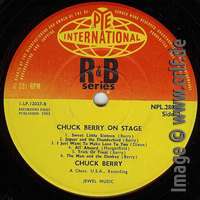
This longer fade is also on the 1970s US orange/blue re-issue LPS-1480. The LPS version has been electronically altered to sound like stereo. To create this âenhancedâ variant CHESS/GRT modified the original longer tape and created a new master called 12477_S/12478_S.
Likewise the 1964 variant released in East Asia (Japan and Taiwan) was created from the longer master tape since
How High The Moon has the longer fade here as well. There is a huge difference, though. The East Asian versions miss the instrumental
Surfing Steel completely! The song was removed from the tape giving a smooth transition from
Maybellene to
Let It Rock.
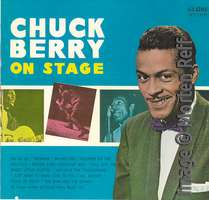
We can only speculate why this was done. Maybe the tape sent to Japan was damaged, maybe there was a company or legal rule not to include instrumentals, or maybe
Surfing Steel would translate to bad language in Japanese â pure speculation as said. Or maybe it had to do with the liner notes on the US cover saying
We guarantee that you wonât be able to sit still when you put this album on your turntable and hear Chuck Berryâs versions of Maybelline, Surfinâ USA, Memphis, All Aboard, Trick or Treat and seven other numbers.
So the Japanese took this literally and reduced the thirteen track album to twelve numbers. Note aside: The British could count and changed the word
seven to
eight on the PYE release.
Another interesting aspect of the Japanese release is the corrected track listing on the back cover. The printed cover has a track listing which follows the incorrect list on the US cover, i.e.
Go Go Go after
Rockin' On The Railroad. This fault was repaired using a yellow sticker which lists the correct track order. The initial Japanese records, probably those used as promo copies, came with a white Imperial label and a thin sticker through which you can see the original print. Later records then had a Globe label and an opaque sticker.
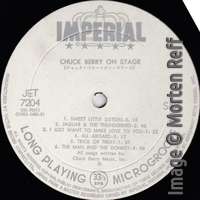
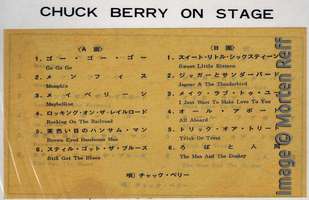
In 1982 the
On Stage album was re-issued in Germany as part of a 2 LP set along with
Rockinâ At The Hops. This version has
Surfing Steel but omits
How High The Moon completely.
And finally thereâs the most interesting French version, released on Barclay 80258 in March 1965 as
Chuck Berry A L'Olympia. This variant of
Chuck Berry On Stage contains the same recordings in the same sequence, though without the two songs having Rodney Jones overdubbed:
Go Go Go and
How High the Moon were cut off. Instead the French had their own announcer. Eddy Mitchell, a successful RockânâRoll singer by himself, is heard with a French language introduction to side 1 which then starts into
Memphis, Tennessee. And Chuck Berry himself speaks the introduction to side 2. In addition a few shouts and stage banter from Berry is merged in between the songs on the tape. Berry refers to Paris and tries to speak French. Both Eddy Mitchellâs introduction and Berryâs segments have been recorded at a Paris concert on February 7, 1965. So this is Chuck Berry on stage, indeed. Just the songs are the same as on the US version having the fake audience.
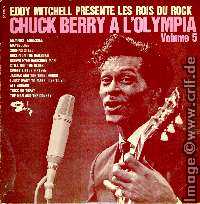
As always: Many thanks to Thierry Chanu and Morten Reff for providing images and a lot of additional information about the 'Chuck Berry On Stage' album.
[Edit 08-01-2018: Added comment and images for the Japanese sticker version.]
[Edit 08-01-2019: Added Ron Malo quote.]
